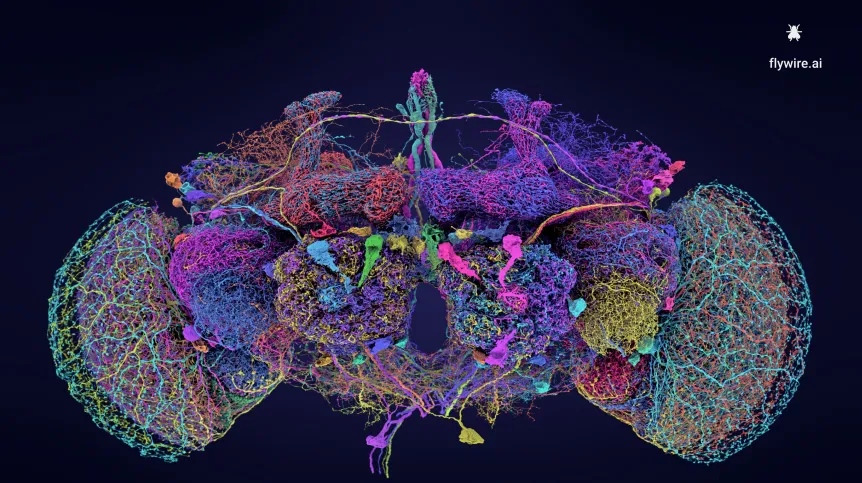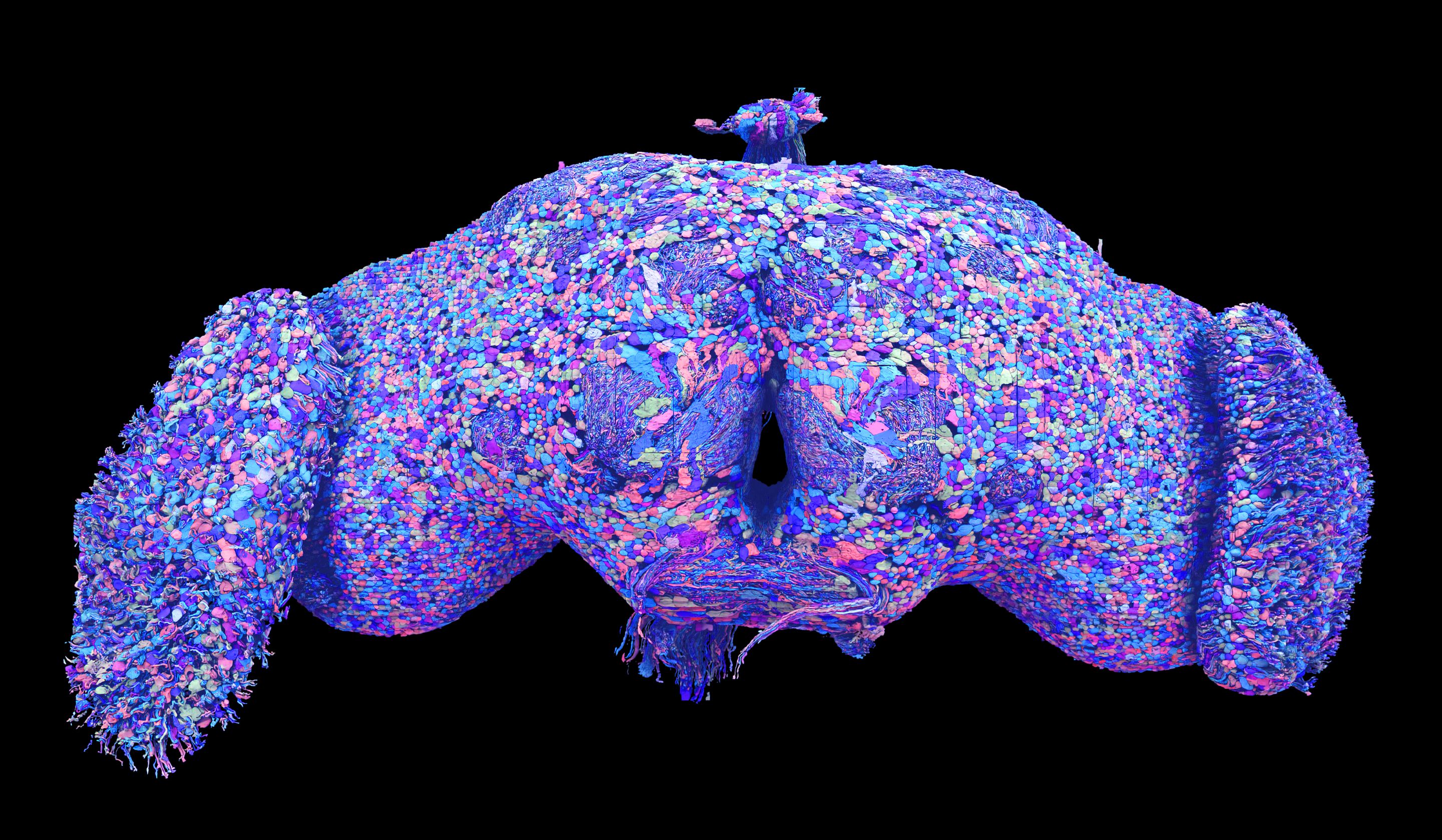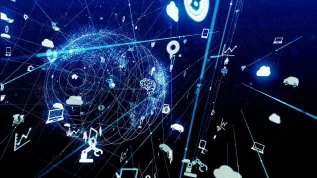
One of the most important scientific achievements of the year - describing the connections in the entire brain of a fruit fly - was achieved not only thanks to laboratory research, but also thanks to the meticulous work of online game players.
Among the co-authors of the paper in Nature - and the most committed volunteers - is Krzysztof Kruk, a science hobbyist from Kielce.
A series of papers was published in Nature at the end of September, describing the first complete connectome - or diagram of neural connections - of the entire brain of a female fruit fly (Drosophila melanogaster).
BRAIN DESCRIBED
A huge international team led by Sebastian Seung and Mala Murthy from Princeton has described approx. 140,000 neurons. The researchers have also shown how more than 50 million connections between these cells work. This has allowed them to determine how some circuits in the fly’s brain (for example, those related to vision) work, and scientists around the world can test the functioning of other networks. As part of the study, the scientists have also identified and labelled 8,000 types of nerve cells (about half of them previously unknown).

Krzysztof Kruk, who did the research as a hobby, did a large part of this painstaking work. Many Polish scientists would kill to have a publication in Nature. Krzysztof Kruk only did what he liked - he played an interesting citizen science game.
'I devoted entire days and many months to this work and managed to independently identify and label almost 50,000 neurons. This is over 1/3 of all neurons in the brain of a fruit fly', Kruk tells PAP.
His involvement in the project was so enormous that - unlike other players - he was mentioned by name among the authors of the publication in Nature.
'For many years I have been struggling with generalized anxiety disorder, which in my case manifests itself, among other things, as the fear of contact with people (called sociophobia). As a result, I have been unemployed for a long time. As a result I have a lot of time at my disposal, which I can devote to citizen science, among other things', Kruk says.
He adds that he became interested in research on the functioning of the brain precisely because of his problems with the nervous system.
IMPORTANCE OF THE DISCOVERY? HEAVIER THAN A FLY
The human brain may have a million times more neurons than the brain of a fruit fly, but before scientists can fully describe and understand what is going on in our heads, they need to work out the functioning of smaller nervous systems. And the brain of a fruit fly is a great piece of equipment! After all, an insect is able to observe its surroundings, fly, navigate, remember information, make decisions, participate in social interactions... And all this thanks to an organ with a diameter of less than 1 millimetre...
UNTANGLING 140 THOUSAND WIRES
In textbook illustrations, neurons are usually ethereally suspended in the void and barely connected to their neighbours. In reality, neurons in the brain are sticky, bent, tightly intertwined, and if that were not enough - each of them has a lot of finger-like endings with which it intertwines with dozens of other cells.
Have you recently looked into the drawer where you keep all those old cables that 'will definitely come in handy at some point'? Now imagine that there are 140 thousand cables in a box with a diameter of 1 mm, and each of them is sticky and has hundreds of branches. You have to recreate the cable system and indicate how they connect to each other and what circuits they create. And the only way to do this is to cut this 'cable system' into slices and look at subsequent cross-sections.
NATURAL INTELLIGENCE SUPPORTS THE ARTIFICIAL ONE
Fortunately, artificial intelligence has come to the aid of scientists. It is able to efficiently glue fragments of neurons from 3D brain scans. However, algorithms - even with their current capabilities - are still far from the capabilities of the human mind. Computers still make so many mistakes that they have to be corrected manually, and this is a titanic task.
Scientists who worked on the connectomes of various animals came up with the idea of asking Internet users for help long ago. It turned out that there were quite a few bright minds in the world who were willing to help scientists not for money, but out of a sense of mission, curiosity or boredom. The natural intelligence of thousands of players from all over the world therefore accelerates the work of artificial intelligence.
AMONG EAGLES
For example, as part of the EyeWire project, for years volunteers have been 'untangling' visual neurons of the mouse brain. Among the most distinguished EyeWire players is Kruk, who is not a professional researcher at all.
Kruk has no education in neuroscience or bioinformatics. He is 40 years old, he graduated in electrical engineering from the Kielce University of Technology. Research in the field of connectomics simply became his hobby at some point.
Kruk recalls that he joined the EyeWire project eight years ago after watching Amy Sterling's TEDx lecture, when the project was already underway.
3D COLORING BOOK
The goal of the EyeWire game is to recreate the connectome for a fragment of the retina of a house mouse.
If you join the project, you will see a tangle of small shapes in a black and white 3D brain scan. This is a cross-section of the mouse brain. In the game, you browse subsequent brain slices and, looking at them from different perspectives, find missing fragments of a given neuron, unnoticed by the AI. You colour them, and then, with further help from the AI, gradually recreate the entire neuron.
'The authors of this project compare EyeWire to a colouring book, only a three-dimensional one. Since I was a child, I have liked colouring books and connecting numbers to create a picture. So when I started playing, I swallowed not only the bait, but also the hook, line and sinker', says Kruk. He proudly adds that he only recently scored 100 million points in EyeWire and overtook the previous leader of the all-time ranking.
ADVANCEMENTS AND NUANCES
For players to get involved in the project and return to it with pleasure, the creators of this project prepared research tasks in the form of an engaging competitive game. Among other things, there are planned game systems, classifications and awards for the best players.
The co-author of the paper in Nature recalls that over time he began to approach solving problems in the game creatively - he not only performed tasks proposed by the creators, but also began to develop his own programs and scripts to speed up work on the description of neurons.
After a few years, the most advanced players were invited to work on the connectome of another model organism - the zebrafish.
'I spent almost six years in the Eyewire (+Zfish) project, becoming one of the most active players, chat moderator and unofficial developer in the meantime', says Kruk.
In 2022, a group of the most advanced players received an invitation to another project - FlyWire, which had been ongoing for a long time. And only here the goal was to recreate the full connectome of the fruit fly brain.
PRETTY FLY FOR A FLY EYE
Players have focused - so far - on the neurons responsible for vision. Processing visual information is one of the most complex tasks in the fly brain. The right optic lobe of this insect involves 38,000 neurons, which is every fourth nerve cell in the brain.
Then it was necessary to describe the fly neurons. And this is exactly what the hobbyist researcher from Kielce did. His work in the project - writing programs and describing neurons - was titanic.
CITIZEN SCIENCE - SCIENCE IN ITS PUREST FORM
'I became interested in citizen science a dozen or so years ago, when I learned about projects such as Folding@Home, Foldit, or Seti@Home. It was then that I understood that science can be done not only by working as a scientist employed at a university or in a large enterprise. Today, it can be done by anyone with access to a computer and the Internet. And you do not have to be a genius', he says.
'For me, citizen science has the great advantage that it does not require additional didactic or administrative work. You do not have to write papers, give lectures, apply for grants, or deal with any documentation not directly related to a given project. In this respect, it is probably science in its purest form', says Kruk.
BE CALM... AND UNDERSTAND THE NERVOUS SYSTEM
'At first, my participation in such projects was rather occasional. About eight years ago, however, I began to experience the first psychological and somatic symptoms, which later turned out to be generalized anxiety disorder. As an engineer, in addition to seeking help from therapists, I also wanted to learn about the causes and mechanisms of these disorders. While searching the Internet, I came across Amy Sterling's presentation about EyeWire', he says.
Kruk now hopes that in the near future people will be able to describe the entire brains of small mammals (mice), and soon after - the brains of primates and finally humans.
However, even if you read about the description of the first connectome of the human brain in a few or a dozen years, there will still be a lot of work to be done. It will be necessary to compare the structures of many human brains to learn about the similarities and differences in their structures - including the differences in the structure of the brains of healthy people and those affected by various diseases, be it mental or neurological.
'When we learn about these differences - if not in this generation, then in the next - maybe we will be able to find fully effective cures for all such diseases. And then I hope that it will be possible to prevent many such personal tragedies as the one that unfortunately befell me', Kruk says.
WHY WE NEED THIS WORK
The volunteer sees these results as the greatest hope for accelerating progress in the development of artificial general intelligence (AGI). 'An important component of building such intelligence will be modelling it on the work of real neurological circuits', he says.
Working with increasingly larger brains requires creating increasingly better algorithms that do not make so many mistakes. And for this, a large database of examples must be developed for the machines to learn from, says Kruk.
Ludwika Tomala
tr. RL













